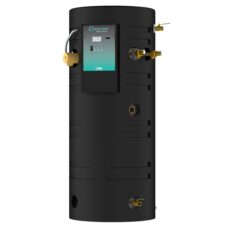Compact Condensing Water Heaters Bring High Efficiency and Reliability to Commercial Applications up to 1200 MBH
PVI, a Watts brand, expands its Conquest® family of compact, condensing, semi-instantaneous, firetube water heaters with 1100 MBH and 1200 MBH units rated for indoor or outdoor applications. With the new, larger-capacity water heaters, the Conquest family supports direct hot water (DHW) demands from 199 MBH to 1200 MBH, for optimal sizing and higher operating efficiency and return on investment (ROI) in new and retrofit commercial applications.
 Conquest 1100 and Conquest 1200 water heaters deliver high efficiency through a completely submerged, single-pass, down-fired design, which includes an array of helical fire tubes. Combustion gases are counter-flow to the direction of the potable water, enabling the coolest flue gases to contact the coldest water and raise low-fire efficiency to 99%.
Conquest 1100 and Conquest 1200 water heaters deliver high efficiency through a completely submerged, single-pass, down-fired design, which includes an array of helical fire tubes. Combustion gases are counter-flow to the direction of the potable water, enabling the coolest flue gases to contact the coldest water and raise low-fire efficiency to 99%.
To reduce burner cycling during periods of low hot water demand, Conquest water heaters employ burner modulation with a variable speed blower. This allows low flow conditions to be met with continuous, low BTU input and without short-cycling. The reduction in energy input also helps achieve the exceptional thermal efficiency while lowering operating costs. During periods when nominal demand is only a few gpm, the at-temperature storage capacity of the Conquest can meet the hot water requirement for 20-40 minutes before a burner cycle is required.
Built from the finest materials, the Conquest 1100 and Conquest 1200 provide superior ROI with 3-5 times the warranty of competitors. The water heaters feature a submerged combustion chamber and heat exchanger with a dimpled array of firetubes fabricated entirely from durable AquaPLEX® duplex stainless steel alloy. Unlike 316L stainless steel, the AquaPLEX tank is inherently immune to chloride stress corrosion cracking and eliminates the need for a tank lining or anode rods.
An electronic operating control provides a plain-text user interface that indicates heater status, modulation rate, operating parameters, and fault status to facility managers and owners. The control is embedded with Modbus RTU and BACnet MS/TP protocols for straightforward connection to a building automation system (BAS).




Join the conversation: